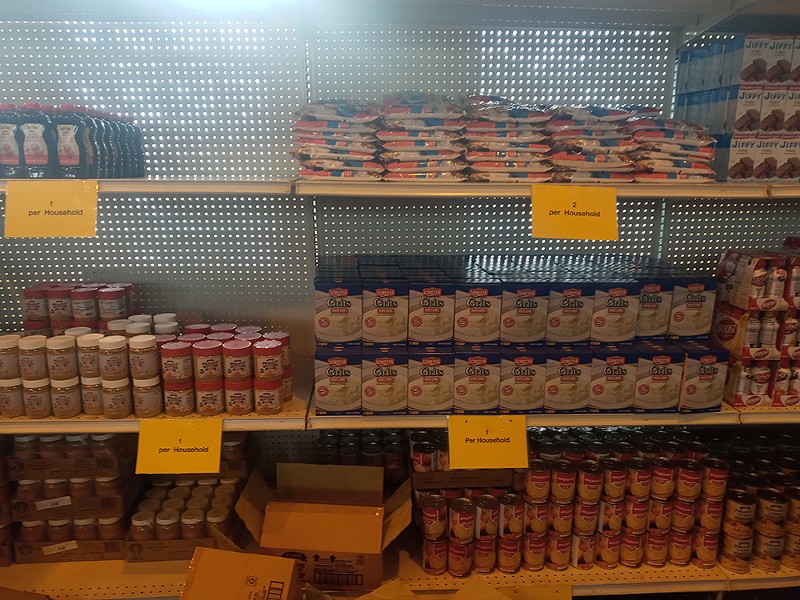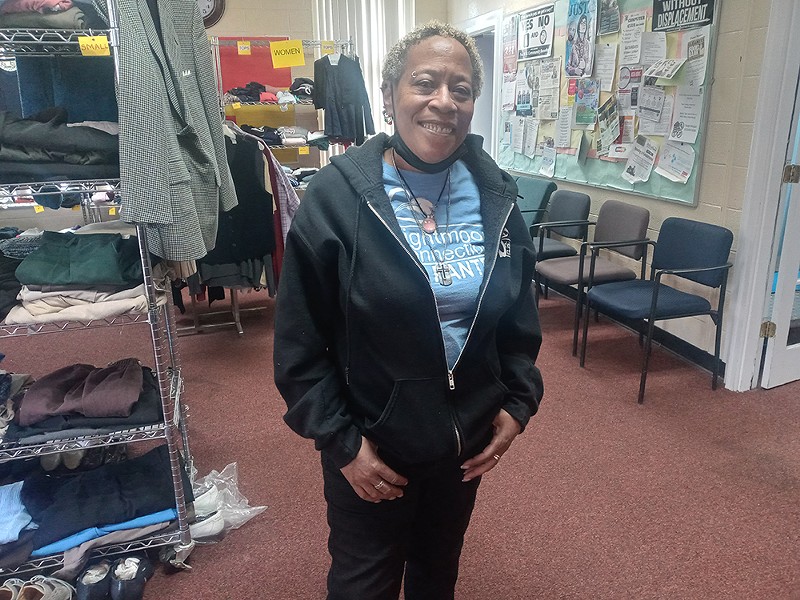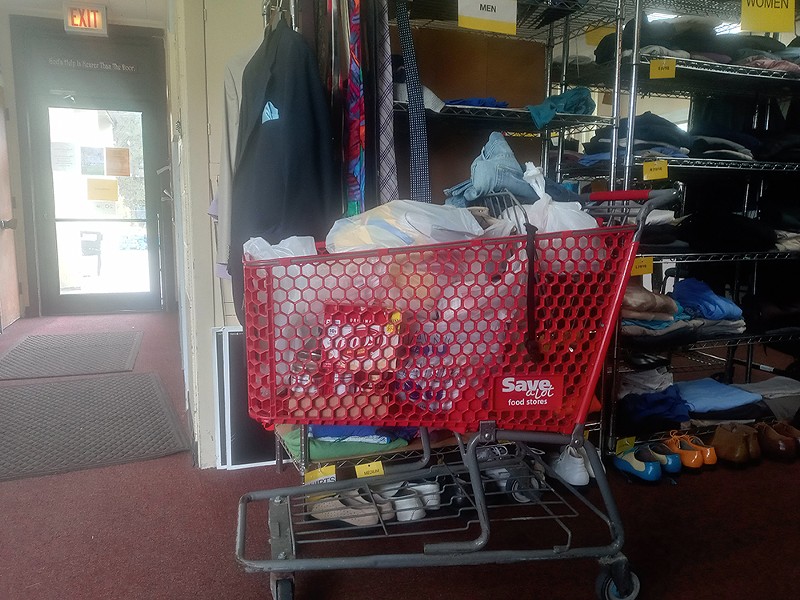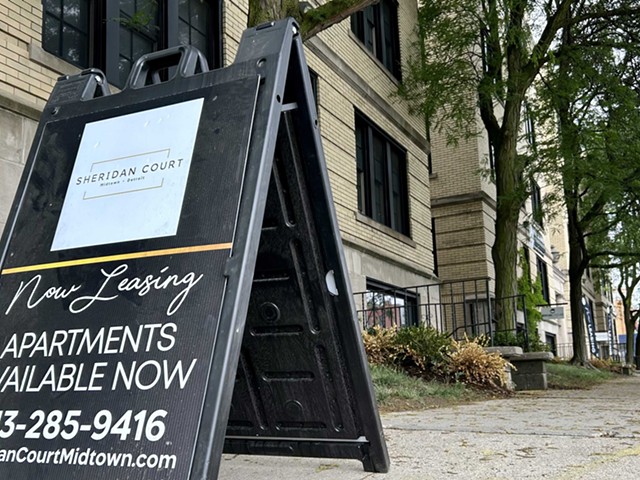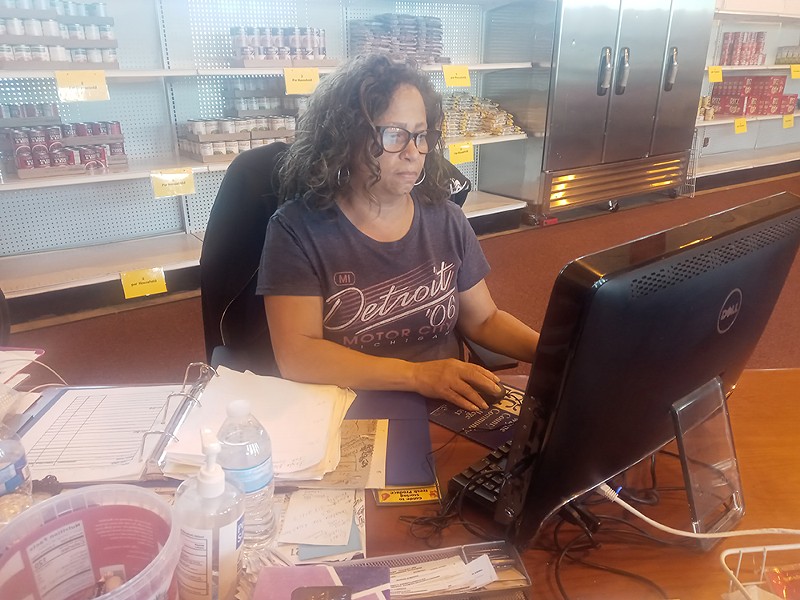
Inside a house of worship lies a house for dignity.
Cleanliness feels sacrosanct, and here people can shop for food without the shadow of shame. On this first Monday in May at Brightmoor Connection Food Pantry, Rev. Roslyn Bouier isn’t waiting for saviors. The pantry’s executive director sees an aggravating cycle of scarcity. “It is extremely, extremely hard for folks right now,” she says.
In her ongoing crusade against food insecurity, or uncertain or limited access to adequate foods, Bouier has recruited a mini-infantry of volunteers to serve the Brightmoor community. They hurriedly, purposefully, unload 44,000 pounds of food purchased from Gleaners Community Food Bank.
A blend of young adults, 30-somethings, retirees. Their ebullient attitudes are contagious and ageless. They drag dollies packed with precious, edible cargo: bags of long grain rice, packages of whole chickens, giant, pill-shaped watermelons.
The dollies rolling over the smooth and spotless carpet again and again exude a giddy pageantry, like floats in a parade. Roughly a dozen volunteers neatly stock and organize the items onto khaki-hued metal shelves without complaint.
The soldiers of charity, powered by reverence and grace.
Because tomorrow, and the days following, the families will arrive. They are united in their scrambling to fill their fridges and cupboards, united in their lack of affordable options. So they come here.
They’ll pass by the basketball hoop in the parking lot, open the glass door, and sit on the blue-cushioned bench for their shopping appointments.
Some will unveil their sorrows. Others, propped up by radiant smiles. They will pick up proteins and ingredients fitting for wholesome, well-rounded meals. They’ll hope to stretch these meals for just a few more weeks before the harrowing mental calculus of where the next ones will come from restarts.
Here, miles away from downtown, people are fighting for their survival, one box of oatmeal at a time.
The disease of food insecurity is relentless, and by late afternoon, the reverend is tired.
Bouier spent the day darting around the pantry like a general, monitoring the inches of every detail. Making this pantry look pristine is necessary when volunteers welcome and embrace families. And the stories they carry like crosses.
The buzz of volunteer activity now subsided, the reverend sits at her wooden desk and rifles through paperwork. Bouier wonders whether the hulking masses of food that rumbled this pantry to life will be enough.
“It may last three weeks, if I’m lucky,” she says.
Tomorrow’s harvest, another showcase of endurance, is hours and hours away.
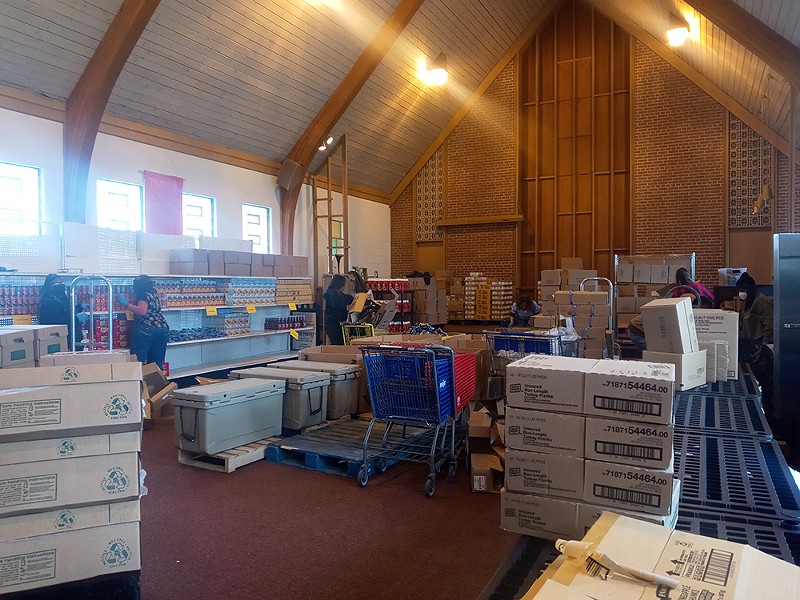
Constant states of emergency
Each day, Bouier is confronted by harsh facts. She’s witnessed the pain of others up close. Within the four square miles of Brightmoor, a majority-Black northwest Detroit neighborhood where thousands of residents call home, poverty rates are high, incomes are low, water shutoffs remain a scourge, job opportunities aren’t a given, and the mass exodus of residents over decades has left its striking footprints in the form of vacant houses.
In response, Brightmoor Connection has provided a people-powered safety net since 2008. Their current headquarters is nestled on this humble corner of Lahser Road and Ulster Street.
The pantry serves thousands of families who live in the neighborhood and surrounding areas each year and receives funding from the Fisher Foundation, Total Healthcare Foundation, and Global Disaster, United Church of Christ. The pantry employs what’s called a “client-choice” model, where pantry users, whom Bouier calls “clients,” can book an appointment and shop for food they desire, a departure from some old-school food pantries where people receive a standardized box of pre-selected goods.
This model has been adopted by food pantries across the country, and researchers say client-choice can reduce food waste and foster an atmosphere of autonomy and self-determination. The approach matches some pantry users’ needs and preferences. In Minnesota, pantry users ranked the ability to choose their own food as a top priority and most often requested healthy food options, a client survey revealed.
In Brightmoor, the pantry is open three days a week, and each client can pick up food once a month. Each visit provides anywhere between five to 10 meals. The curation of foods include meat, non-perishable products, fresh fruits and vegetables sourced from local urban farms, and morsels of sweetness. In some cases, fudge brownie mixes are considered a luxury.
The volunteers are the pantry’s soulful engine. Many of them also use the pantry’s services and hold decision-making power. They help choose which foods the pantry stocks. They’re also civically engaged, often present at city council meetings. “They fight for communities. They’re fighting for equity,” Bouier says. “And they’re fighting for self-determination to be seen as human beings, not just pantry participants.”
The pantry’s mission moves beyond meals. There’s an open closet of donated clothes and shoes near a bulletin board littered with fliers and announcements. The pantry also raises money for clients’ food, water bills, utility bills, even a used tire. People’s survival hinges on these lifelines. “You can’t pull your way out of poverty,” Bouier says. “You can’t pull yourself up by the bootstraps.” They also serve as a bridge to wellness and education, offering yoga, aroma therapy, cooking and adult computer classes, and act as a hub for community organizing and justice work.
These services aid clients braving the bruising shortfalls of chronic poverty and constant states of emergency. Some visiting the pantry already work two or three low-wage jobs, and others can’t pay for childcare. One is dealing with a broken furnace and another family is living in a motel. Another lives in a car.
Now the rents are rising, and Bouier knows many families are getting evicted. The fear of losing shelter means the loss of cash moves with greater velocity, leaving little left over for meat, bread, and milk.
Food pantries are feeding people trying to survive punishing economic realities. While grocery store prices in the U.S. have started to slowly decrease, they remain 7% more expensive than one year ago.
In Detroit, a handful of longtime grocers have shuttered. Small grocers are often converted into dollar stores. In 2020, dollar stores outnumbered full-line grocery stores in the city.
The infusion of emergency food assistance benefits, which lifted many Black and Latino households out of poverty, is gone when food emergencies pervade many corners of America.
In Michigan, emergency allotments from the Supplemental Nutrition Assistance Program (SNAP), which serves roughly 1.3 million people across the state, ended in March, dealing a financial blow to families already struggling. Households lost at least an extra $95 a month.
Slashes to benefits are driving more bodies to pantries who are struggling to provide as demand rises and the amount of food donated by the U.S. Department of Agriculture is drying up.
The damage wrought by food insecurity strikes communities of color with more pronounced force. Across the nation, one in five Black and Latino and one in four Native American people lived in households who struggled to access healthy and adequate food in 2019, symptomatic of the ways systemic racism drives the crisis. Black mothers, researchers note, are more susceptible to scrutiny and surveillance of their food practices if they struggle to feed their children.
Statistics lay bare the scope of the problem in Detroit, a city historically plagued by racist policies and practices, including redlining and the destruction of Black neighborhoods to make room for highways. About 69% of city households were food insecure, according to a 2020-21 Detroit Food Policy Council analysis.
Ask volunteers, the lifeblood of the pantry, about the challenges of buying food these days, they’ll shake their heads, release an audible sigh, noticeably deflate.
Linda Mack, a pantry volunteer, General Motors retiree, and National Guard veteran, knows some people in Brightmoor don’t have savings, don’t have a bank account, marching to the drumbeat of getting by.
Some friends, close in age, now receive just $18 a month in food benefits, having previously relied on the injection of extra assistance the government provided. Mack questions the wisdom behind these cuts.
“What can you do with $18? Buy a dozen eggs?” she says. “That’s half your money almost right there.”
A volunteer at the pantry for more than a year, Mack treats clients with dignity. Being here opened up her heart. Before volunteering, Mack drove by sprawling pantry lines. Judgmental thoughts skipped through her head. The days spent living altruistically gave her a jolt of humility. These everyday struggles don’t seem so strange anymore.
“Just because you don’t have money to buy food or clothes, doesn’t mean you’re less than,” she says. “Because that could be me tomorrow.”
Delores Green-Wyatt, another volunteer, fires a warning against the unholy stench of rotten meat that she’s noticed permeating a nearby market.
“It just reeks,” she says. Shopping there is often a last resort for the perpetually cash-strapped. So are gas stations and liquor stores. And some smaller markets, volunteers say, carry expired pops and noodles.
“But the community has no choice,” she says.
The presence of a big chain grocery store doesn’t guarantee relief from subsisting on a diet of old, salty, mass-produced snacks. Half a mile away from the pantry, a Meijer stands on a major road peppered with hair braiding salons and fast-casual haunts. Yet inside, the prices of meat, eggs, and cheese, Green-Wyatt says, are too high for the clients the pantry normally serves. Paying for these products isn’t worth the trouble.
Lately, Green-Wyatt has watched some grocery store shelves empty more quickly, meaning more return trips are necessary — if a commute is even possible. A third of Detroiters don’t own a car, and the bus system is widely considered unreliable, hamstringing the hunt for kitchen staples.
Born and raised in Brightmoor, Green-Wyatt feels a debt of responsibility. She wants clients to shop comfortably, to find a much-needed reprieve from their hardscrabble lives. They may not be blood relatives, but she cares for them as if they were kin.
She’ll prepare to-go bags of pineapple chunks, canned pink salmon, rice, applesauce, or peanut butter and jelly for clients who don’t have time to shop. She also plays the role of communications officer, making copies of fliers promoting the pantry’s services, as well as janitor, helping keep the building clean.
Her sense of purpose, unbending.
“We’re in this together,” she says.
A mother of six children, Green-Wyatt knows the hardest days of staying afloat weren’t so long ago. She remembers having trouble buying food and maintaining her household when she was younger. But the question of when the next meal comes may not always last. She reminds clients the struggle to buy food can be temporary.
They'll need more lifelines, Green-Wyatt says, to escape this limbo. She has a message for new people planting roots in the neighborhood. If you come, commit to the cause of supporting people already here.
“Help build and grow the community,” she says.
Another daughter of Brightmoor, Ivory Thomas, devotes the hours of her day to picking up and organizing donated clothes. The friendly ambience makes her feel safe and comfortable.
“I don’t really have much time for myself,” she says. “But I take the time for myself to be up here.”
Inside these walls, giving care is a love language.
The matriarch of her household, Thomas looks after her three children. Earlier in her life, Thomas was touched by the reverend’s grace. “I really didn’t know who to go to until I met her,” she says. She helped Thomas pay bills when money was tight. She gave Thomas counsel as the memories of surviving sexual abuse as a teenager scraped her soul. Even as she raised her children. Even as the decades flew by.
Thomas tidies the clothing closet because of her.
Sometimes weary clients walk into the pantry. Their lives adrift.
“It’d be sad moments where they come crying, saying that they ain’t happy, that they needed help,” she says.
Thomas holds space for their grief. She’ll try to cheer them up, encourage them to keep going and find a way. Because the daughter of Brightmoor knows some clients believe hope doesn’t exist for them.
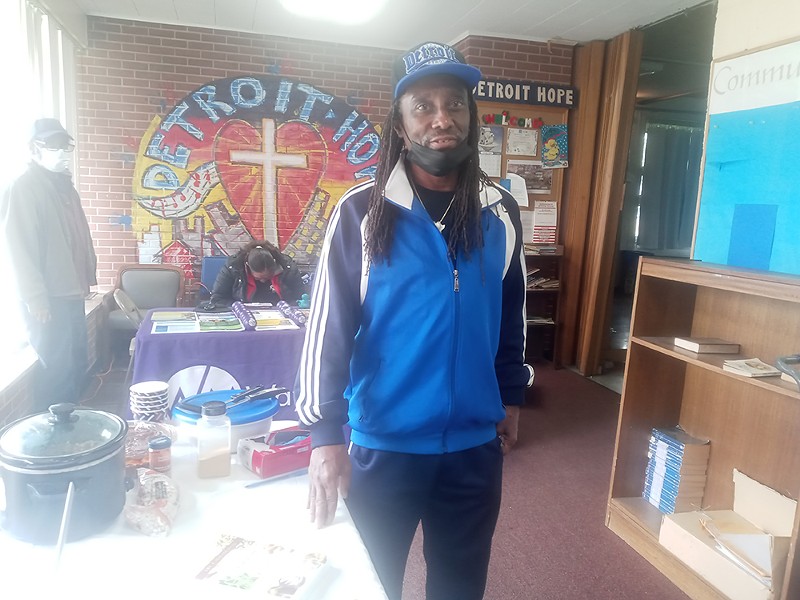
Braided misfortunes
It’s Tuesday afternoon. The sky is blank. The air is chilly after a rainstorm. Tree branches flutter in the wind. In the heart of the pantry, Bouier corrals the volunteers into a circle and boosts their spirits as they prepare for another day of service.
Her voice grows louder, rising and falling like an undulating ocean wave over a floor of silence.
Jesse Brown sits behind a slow cooker warming up a stew of white beans and spinach. Brown, the pantry’s on-site nutritionist, moves with ease and confidence.
Long braids drape over his shoulders. He sports a black, white, and blue tracksuit and a Detroit baseball cap slightly cocked to the side. He hopes the stew, which he cooked himself, will tickle the curiosity of clients passing by.
“The mission is training healers in every home,” he says.
He even brought some health-themed literature. A book detailing how people can incorporate seeds and nuts into their diets. Information on heart disease, cancer, strategies to reverse the tides of corrosive eating habits.
A catastrophic brush with illness in childhood shifted his outlook. When he was 17, Brown got very sick. His immune system crashed, and he almost died.
“That was a wake-up call for me,” he says.
His loved ones were also plagued with ill health. His father, who had high blood pressure and heart problems, died at 76. Three grandparents died before he was born. Those losses fueled him to evangelize about the values of nutritious meals full tilt. He then became his family’s go-to expert on wellness.
As a naturopathic doctor, he sees himself as a steward of lost knowledge, a conduit for the ancestors. When people used to cultivate the land and grow their own fruits and vegetables before the era of fast food franchises. Having ownership over small and intimate harvests, returning to these simple ways of life, could curb the threats of chronic illnesses.
Diabetes. High blood pressure. High cholesterol. Inflammation of the joints. Some clients have asked Brown how to battle these conditions, damaging side effects of food insecurity prevalent among underserved communities of color like Brightmoor.
As part of his healthy eating ministry, Brown creates recipes and meal plans for breakfast, lunch, and dinner based on the pantry’s inventory. These meals, Brown says, can still be flavorful, nutritious, and satisfying. Once clients learn his cooking tricks, they’ll no longer need the daily dose of Doritos from the gas station.
Brown enjoys cooking and serving plant-based meals for clients. Next to the slow cooker filled with white beans and spinach, Brown also brought separate dishes of baked beans and couscous.
The exposure to simple, healthy dishes can help promote regular, lasting lifestyle changes.
“I see people being more ready, willing to learn and make different choices now than ever before,” he says.
“Just because you don’t have money to buy food or clothes, doesn’t mean you’re less then. Because that could be me tomorrow.”
tweet this
Moments later, clients trickle into the pantry. Near the entryway, a representative from Wayne Metropolitan Community Action Agency, a nonprofit organization helping low- and moderate-income residents with housing, family, and economic needs, sits behind a table. She’s come to provide some resources and guidance. A few clients pump small dollops of hand sanitizer onto their palms, rubbing them together. They sit quietly on the blue-cushioned bench, eyes ahead.
The mood is tranquil. An older woman walks over to the clothing closet. A pair of Santa Claus-red joggers intrigues her, and she places them inside her blue grocery cart. A mother and a lanky young girl also arrive.
The girl ping-pongs across the pantry’s lobby. She jokingly calls an older woman “pickle girl,” and then the slow cooker catches her eye. She scurries over and hesitantly tries the couscous. Her verdict? “It tastes like grits,” she says.
The blissful melody of “I Say A Little Prayer” by Aretha Franklin soars from a desktop computer, then abruptly cuts off.
“Hey, I like that song!” shouts one older client, his bright eyes peeking over his American flag face mask. A long white beard hangs from his chin, embodying the Easy Rider energy of yesteryear.
Another soulful song emanating from the YouTube playlist, “O Happy Day,” provides a soundtrack to the shopping activity, now in full force.
A volunteer shouts out each client’s last name when the time comes for their shopping appointment. They’ll sit in a chair and check in with Bouier, who’s sitting at her desk. Pre-registered clients get a ticket and a return slip for next month’s appointment. She also registers walk-ins, verifies if they live in the service area and have children in the home, listens to a flurry of troubles, needs, and fears. Above all, she honors clients’ desires to be seen and heard. Even if a person doesn’t meet these requirements, Bouier provides some immediate assistance and doesn’t turn away anyone searching for sanctuary.
Then they’ll grab a “buggy” — the word many volunteers use for grocery carts — and head toward the shelves of food. Some examine the products. Volunteers help package canned goods into boxes stuffed with fliers for upcoming computer training sessions. They keep a methodical pace.
The clients fill up their buggies with food. Oatmeal. Rice. Canned sweet peas. They push the carts peacefully. Hardly any client says a word as they shop. Hardly anyone’s in a rush. The song’s harmonies crescendo, ascend.
He taught me how/to walk/fight and pray.
Fight and pray.
The atmosphere mimics the hustle and bustle of a Sunday market.
A 50-something mother carries sleepy eyes and braided misfortunes. A journeywoman of the local pantry circuit, drowsiness colors the tenor of her speech.
In the morning, Dwana Parker trekked to the thrift store near Nine Mile and Coolidge, hoping to score a haul of clothes during a special $1 sale. As cold rains poured, she then made her way to a pantry line spilling out from a church on Fenkell Street, where she’d been the 243rd person waiting to pick up food.
Today, her leg was hurting. She’d just gotten an injection from the doctor. Parker has a plate in her right tibia. She receives disability benefits and doesn’t work because of her chronic pain.
Recounting her past trips across the city, pantry lines can morph into chaos. She’ll strain herself to suffer “the bullshit conversations” and encounter bland selections: “chicken, chicken, and more chicken,” but remains grateful for the harvest. Parker doesn’t want to appear greedy, knowing the needs of others far outstrip hers. “Some people,” she says, “are in worse situations than I am.”
Today, she couldn’t suffer the rain.
“To hell with it,” she told herself. “I’m not about to get sick.”
Now she’s making a pit stop at Brightmoor Connection Food Pantry. She rests on the blue-cushioned bench and waits for her turn to shop. All things considered, she’s in a fair mood but would rather be home. Her three adult sons live with her.
An arabesque of gospel song piano trills pirouettes in the air. Parker plans to pick up ground turkey, her sons’ favorite. She’ll use the meat for tacos and spaghetti. She sees two pairs of Levi blue jeans, baggy fit. She snags them off the metal shelf. The jeans are for her sons.
Waves of cuts gave rise to days of scarcity. Over the last year, her food assistance benefits dropped from $600 to $300 per month. Starting in May, Parker says she’ll now receive $157 per month. “That $95 allotment [SNAP] was giving. That helped out. Now that’s over with,” she says.” As a result, Parker’s become a regular fixture at food pantries and a participant in an unsavory dilemma: the exhausting forage for charity, clothing deals, and free meals.
“Running out, not being able to get the necessary needs,” she says. “Food insecurity’s really horrible these days.”
It’s late afternoon. A short, middle-aged woman finishes her shopping appointment. She drags white plastic bags filled with chicken.
Nichole Jackson, who once worked in the medical field, believes she walks the world alone. She doesn’t know how many meals she’ll make from the few packages of chicken she retrieves.
“Imma make it last,” she promises.
She waddles by a skinny tower fan and a shelf carrying piles of old novels and CDs. As the hours pass, some clients pick up perforated beige loafers, saffron orange church shoes, and white, high-top sneakers. All of them vanish as the day of service rolls forward.
Jackson speaks in broken whispers. She doesn’t want to “milk” the pantry’s charity. She tries her best to do the right thing. Right now, her mind is elsewhere. Her search for food seems a faraway problem.
Soon, she’ll step outside these doors, away from the praise music, the sputtering chatter and toward the threats awaiting inside an apartment complex on Lahser Road, where she lives by herself.
Her fight for survival is bigger than any pantry could solve. Jackson says the water streaming from the pipes is undrinkable, and the apartment’s management company ignores her complaints. She doesn’t want her mail getting stolen. She doesn’t want her $745 monthly rent to rise. She wants some of her neighbors to stop harassing her.
Her deluge of fears makes her cry. A semblance of safety, stripped away. Because of a degenerative bone disease and post-traumatic stress, she can’t work a job. She doesn’t reveal the origins of her emotional pain.
She mourns the person she used to be. She’s lived this way for a long time.
Jackson will be here, shopping for food, next month. “Of course I come. I come every month,” she says. “I don’t have a choice.”
Her moment of life, adrift.
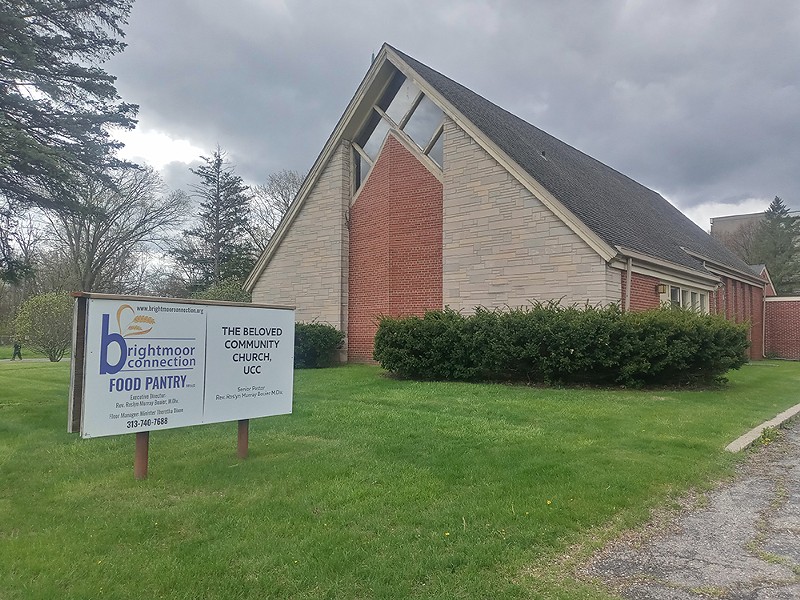
Unbroken covenant
Recently, Bouier got an invitation to a celebratory dinner taking place downtown. The dinner was billed as an inspiring occasion for freedom and justice, featuring one of the city’s billionaire developers. The invite failed to entice her.
“They don’t do anything for the people in the city,” she says.
Making nice with the upper echelon of Detroit’s power brokers isn’t her concern. She scoffs at the audacity of such a gathering. Meanwhile, the rest, many people in Brightmoor, experience financial hardship.
Bouier condemns the wisdom of giving billionaire developers tax breaks while working families claw for ways to survive. “It’s a choice,” she says. A choice to keep the status quo of inequity.
“At the end of the day, people are really pressed up against the wall,” she says.
Bouier has witnessed the pain of people’s struggles up close, making her a fighter practically all her life. She grew up in Highland Park, another city roiled by job losses and disinvestment.
Then she moved to Detroit, where she raised her children. She became a vocal critic of city officials, a public speaker, an activist for social justice, a pastor. A spitfire always putting out fires for people.
Hard times also gripped her life. She once was addicted to drugs. Her drug use made her run away from embracing her faithful vocation. People saw her as a pariah. She doesn’t want clients, who have been made to feel shame and fault over their struggles, tainted by the same harsh gazes.
“People shouldn’t be ostracized or penalized because of their socioeconomic class,” she says.
The return of blazing sunshine and heat and children out of school means more mouths to feed and bodies to clothe. Bouier knows a food pantry is just a Band-Aid. But the demand is growing. The need is so high.
She rattles off a litany of remedies she believes could lift the pressure off families navigating a constellation of hardships: better paying jobs, low-cost housing, a sustainable economic infrastructure for Black and brown people.
And the pantry can’t afford to cease the work of providing lifelines, despite the economic climate that’s hurting the operation. Inflation has driven up costs for purchasing food for the pantry, forcing Bouier to make a hard choice.
She’ll have to drop the poundage of food clients can take home from 110 pounds to 85 pounds, so she can stretch the food as far as she can. She’s applying for grants to help stimulate the pantry’s finances.
In the fight to preserve Brightmoor, the pantry is not alone. Deeply Rooted Produce, Brightmoor Artisans Collective, Neighbors Building Brightmoor, and other community organizations are rallying resources and knowledge.
They are divining solutions, visions for prosperity, taking action steps: farmers markets, urban gardens, a community tool bank and fridge filled with brown-bag lunches, cleanups of portions of Eliza Howell Park, 250 acres of green space considered a natural treasure and home to the bird-nest like Stickwork Sculpture.
In the 1920s, Brightmoor was a working-class neighborhood for white factory workers. Another kind of resurgence, led by Black residents, is taking root today.
What will Brightmoor be like, half a century from now?
It’s the second week of May. Beams of sunlight pierce through the clouds. Cars whizz by. Bouier’s prediction is starting to come to fruition. Some of the pantry shelves are a little barren. All the bottles of strawberry jelly are gone. The pantry is low on pink salmon and dry spaghetti.
Another delivery day, when thousands of pounds of food arrive again, is weeks away.
The disease of food insecurity is relentless, but so is the reverend, the volunteers, the radical spirit, the unbroken covenant to nourish and restore breathing life into this pantry.
“I’m always hopeful that we’re able to meet the need,” she says. “Righteous dignity and parity will always prevail.”
In the meantime, Bouier hops on her bike. She’ll leave the pantry doors, ride by the basketball hoop in the parking lot, away from this oasis for the stunned, downtrodden, forgotten and toward the post office.
How far can she go? How far can she lead them?
Subscribe to Metro Times newsletters.
Follow us: Google News | NewsBreak | Reddit | Instagram | Facebook | Twitter

